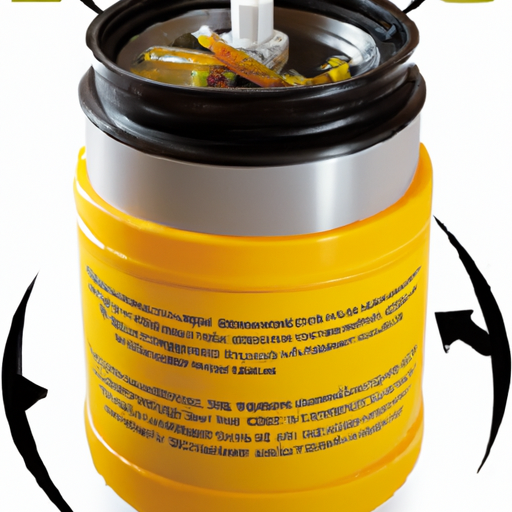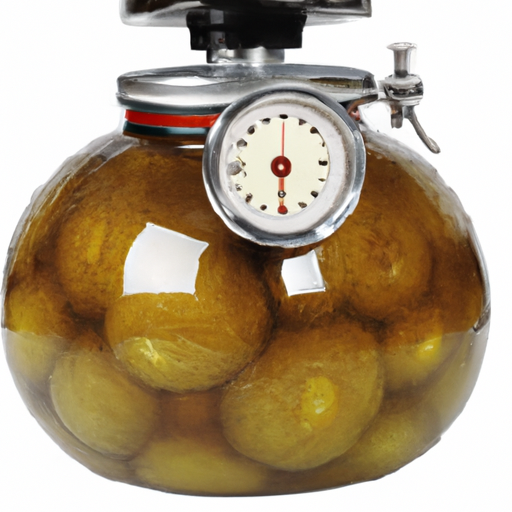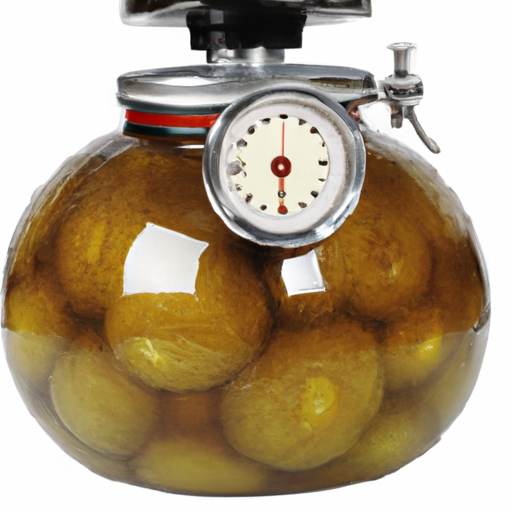If you’ve ever wondered how long it takes to can your own delicious homemade goods using a pressure canner, you’re in luck! With the help of this nifty tool, you can preserve fruits, vegetables, and even meats in a convenient and safe way. In this article, we’ll explore the ins and outs of the canning process with a pressure canner, uncovering the secrets to perfect preservation and the time it takes to achieve it. So, grab your apron and get ready to embark on a culinary adventure!

Understanding Pressure Canning
What is Pressure Canning?
Pressure canning is a method of preserving food using high heat and pressure to kill bacteria, yeast, and molds that can lead to spoilage. The process involves sealing food in jars and then heating them to a specific temperature for a certain amount of time. This creates a vacuum seal, which prevents any further contamination and extends the shelf life of the food.
Why Use a Pressure Canner?
Using a pressure canner is essential when canning low-acid foods, such as vegetables, meats, and poultry. These types of foods have a pH greater than 4.6, which makes them susceptible to bacterial growth, particularly the potentially deadly Clostridium botulinum. By using a pressure canner, the high temperatures reached during the process ensure that all harmful microorganisms are destroyed, making the food safe for long-term storage.
Benefits of Pressure Canning
Pressure canning offers several benefits compared to other methods of food preservation. Firstly, it allows you to preserve large quantities of food at once, making it a time and cost-effective option. Furthermore, pressure canning retains the flavor, texture, and nutritional value of the food, unlike some other preservation techniques. Lastly, properly canned foods can last for up to a year or even longer, ensuring you have access to nutritious and delicious meals throughout the year.
Factors Affecting Canning Time
Type of Food
The type of food being canned plays a crucial role in determining the canning time. Low-acid foods, such as vegetables, meats, and poultry, require longer processing times to ensure all harmful microorganisms are destroyed. On the other hand, high-acid foods like fruits and tomatoes have a shorter canning time since their natural acidity inhibits bacterial growth to a greater extent.
Size and Density of Food
The size and density of the food being canned also impact the canning time. Larger and denser pieces of food take longer to heat all the way through, requiring a longer processing time. Therefore, it is important to cut the food into smaller, uniform sizes to ensure thorough and consistent heating during the canning process.
Altitude
Altitude plays a significant role in determining the canning time as well. Higher altitudes have lower atmospheric pressure, which affects the boiling point of water. As a result, the processing time needs to be adjusted to compensate for the lower boiling point and ensure that the food reaches the necessary temperature for safe preservation.
General Steps of Pressure Canning
Preparing the Canner
Before starting the canning process, it is essential to prepare the pressure canner. This involves ensuring that the canner is clean and in good condition, with no cracks or damage that could affect its ability to maintain pressure. Additionally, the canner should be equipped with a functioning pressure gauge and safety valves. It is also important to check the sealing ring and replace it if necessary.
Filling the Jars
Once the canner is prepared, it is time to fill the jars with the prepared food. It is crucial to follow a trusted canning recipe to ensure safe and successful results. It is important to leave an appropriate headspace in the jars to allow for expansion during the heating process. The headspace requirements may vary depending on the specific food being canned, so referring to the recipe or guidelines is essential.
Sealing the Jars
After filling the jars, it is necessary to seal them properly. This involves wiping the jar rims clean, placing a lid on each jar, and securing it with a screw band. The screw band should be tightened just enough to hold the lid in place, but not overly tightened. The purpose of this step is to create a partial vacuum seal that will allow excess pressure to escape during processing.
Processing the Jars
Once the jars are sealed, they are ready for processing in the pressure canner. The canner should be filled with the appropriate amount of water as specified by the recipe or canning guidelines. The jars are then placed in the canner using a jar lifter, ensuring they are evenly spaced and not touching each other or the sides of the canner. The canner is then covered, and the heat is gradually increased to reach the necessary pressure for the specific food being canned.
Cooling and Storage
After the processing time is completed, the heat is turned off, and the pressure is allowed to naturally decrease in the canner. It is crucial to follow the recommended cooling time specified in the recipe or guidelines. Once the pressure has fully released and the canner is safe to open, the jars can be carefully removed using the jar lifter. The jars should be placed on a towel or cooling rack and left undisturbed to cool completely. Properly canned jars will have a concave lid once cooled, indicating a successful vacuum seal. The cooled jars should be labeled, dated, and stored in a cool, dark, and dry place.
Determining Canning Time
Consulting Reliable Sources
When determining the canning time for a specific food, it is essential to consult reliable sources for accurate information. Trusted sources include reputable canning books, online resources from university extension services or government agencies, and tested and approved recipes from reputable food preservation experts. These sources ensure that you follow safe guidelines and achieve optimal results in your canning endeavors.
Following Recommended Guidelines
Recommended guidelines for canning times are provided by reputable organizations. These guidelines take into account the required temperature and time necessary to destroy harmful microorganisms. It is crucial to follow these guidelines closely to ensure the safety and quality of the canned food. Deviating from the recommended processing times may result in underprocessed food, increasing the risk of spoilage, contamination, or even foodborne illness.
Considering Specific Recipes
Specific canning recipes often provide detailed instructions on the processing time required for a particular food. These recipes have been developed and tested to guarantee safe and successful results. It is important to carefully follow the instructions provided in the recipe, including the canning time, to ensure that the food is properly preserved.

Canning Time for Different Types of Food
Low-Acid Vegetables
Low-acid vegetables, such as carrots, green beans, and corn, require longer canning times due to their low acidity levels. Depending on the specific vegetable and the recipe being followed, the canning time can range from 25 to 90 minutes. It is essential to consult a trusted recipe or canning guidelines to determine the precise processing time for each vegetable.
High-Acid Vegetables
High-acid vegetables, including tomatoes, which have a pH below 4.6, require shorter canning times due to their natural acidity that helps inhibit bacterial growth. Generally, high-acid vegetables can be safely processed for 15 to 45 minutes, depending on the recipe being used and the size of the jars.
Meat and Poultry
Meat and poultry are low-acid foods that require extensive heating to eliminate bacteria, such as Clostridium botulinum, that can cause botulism. The canning time for meat and poultry can vary depending on the size and type of meat being canned. Canning times typically range from 75 to 120 minutes or even longer for larger cuts or denser meat.
Seafood
Seafood, including fish, shellfish, and crustaceans, is processed similarly to meat and poultry due to their low-acid nature. The canning time for seafood depends on factors such as the size and type of seafood being canned. Generally, the canning time for seafood can range from 75 to 120 minutes.
Fruits
Fruits are high-acid foods, which means they require shorter processing times compared to low-acid foods. The specific canning time for fruits depends on the type of fruit and the recipe being followed. Canning times for fruits generally range from 5 to 20 minutes.
Jams and Jellies
Jams and jellies, which are made from fruits and sugar, have different canning times depending on the recipe. The canning time for jams and jellies typically ranges between 5 to 15 minutes, ensuring that the sugar preserves the fruit and eliminates any bacteria that may be present.
Accounting for Altitude
Understanding the Impact of Altitude
Altitude can significantly influence the canning process due to variations in atmospheric pressure. As altitude increases, atmospheric pressure decreases, resulting in lower boiling points for water. This lower boiling point affects the canning time, as the food must reach a specific temperature to ensure safe preservation. It is crucial to adjust the canning time to compensate for altitude to achieve the necessary heat.
Adjusting Processing Time for Altitude
To adjust the canning time for altitude, it is important to consult reliable sources or canning guidelines that provide altitude adjustments. Most trusted recipes and guidelines provide instructions on how to modify the processing time based on different altitude ranges. By following these adjustments, you can ensure that the food reaches the necessary temperature for safe preservation, regardless of your elevation.

Importance of Proper Canning Time
Ensuring Safety of Canned Food
Proper canning time plays a vital role in ensuring the safety of canned food. The specific processing time is designed to eliminate harmful microorganisms, such as bacteria, yeasts, and molds, that can lead to spoilage or foodborne illnesses. Following the recommended canning times minimizes the risk of consuming contaminated food and helps preserve the quality and flavor of the canned products.
Preventing Food Spoilage or Contamination
Underprocessing or overprocessing food can lead to spoilage, contamination, or even the growth of dangerous bacteria like Clostridium botulinum. It is important to adhere to the recommended canning times to ensure that the food reaches the necessary temperature to destroy bacteria, molds, and yeasts. By following proper canning techniques and guidelines, you can prevent food spoilage, maintain food safety, and extend the shelf life of your canned goods.
Tips for Efficient Canning
Organizing the Canning Process
To streamline the canning process and make it more efficient, it is important to organize and plan ahead. Prepare all the necessary equipment, ingredients, and tools before starting. This includes cleaning and sanitizing the jars, gathering the required ingredients, and ensuring that the canning equipment is in good working order. Having everything prepared and organized will help you save time and avoid unnecessary stress during the canning process.
Using Proper Equipment
Investing in good quality canning equipment is essential for safe and efficient canning. Ensure that you have a reliable pressure canner with a functioning pressure gauge and safety valves to accurately monitor and control the canning process. Additionally, using brand-new lids and rings for each canning session ensures a proper seal, reducing the risk of food spoilage. Using appropriate jar lifters and canning funnels can also improve the efficiency and safety of the canning process.
Following Safety Precautions
Canning involves working with high heat and pressure, so it is crucial to prioritize safety throughout the process. Always follow the safety guidelines provided by the manufacturer of your pressure canner. Use heat-resistant gloves or mitts to protect your hands from burns and handle hot jars with caution. Never force open a pressure canner and allow it to cool naturally before removing the lid. By following these safety precautions, you can minimize the risk of accidents and injuries during the canning process.
Maintaining Cleanliness
Maintaining cleanliness and hygiene is vital to prevent contamination and ensure the safety of the canned food. Wash your hands thoroughly before handling any ingredients or equipment. Sanitize all jars, lids, and utensils to eliminate any potential bacteria. Use clean, filtered water to fill the canner and jars. By maintaining a clean environment and handling the food and equipment with care, you can reduce the risk of cross-contamination and preserve the quality of the canned goods.

Common Mistakes to Avoid
Overprocessing or Underprocessing
One common mistake in pressure canning is overprocessing or underprocessing the food. Overprocessing can lead to the loss of flavor, texture, and nutrients in the food, while underprocessing can result in bacteria surviving and potentially causing food spoilage or illness. It is crucial to follow trusted recipes or canning guidelines closely to achieve the recommended processing time for each specific food.
Ignoring Altitude Adjustments
Failing to account for altitude when canning can lead to underprocessed or overprocessed food. Ignoring altitude adjustments can result in canned food that is unsafe to consume or has poor texture and flavor. It is essential to consider the altitude of your location and follow the recommended adjustments for processing time to ensure safe and successful canning.
Neglecting Recommended Guidelines
Neglecting recommended canning guidelines can pose significant risks to the safety and quality of the canned food. It is important to follow reputable sources and guidelines, such as those provided by Extension Services or government agencies. These guidelines have been tested and established to ensure safe and proper canning practices. Neglecting these guidelines may result in inadequate preservation, increased risk of spoilage or contamination, and compromised food safety.
Conclusion
Pressure canning is a reliable and efficient method of preserving food, allowing you to enjoy the flavors of fresh produce and other ingredients throughout the year. By understanding the factors that affect canning time, following trusted recipes and guidelines, and considering altitude adjustments, you can safely and successfully can a wide variety of foods. Remember to prioritize cleanliness, organization, and safety throughout the canning process and avoid common mistakes. With proper technique and attention to detail, you can achieve safe and delicious results in your canning endeavors while also having the opportunity to experiment with different canning recipes. So gather your ingredients, prepare your canner, and embark on a journey of preserving the bounties of nature for months to come.

